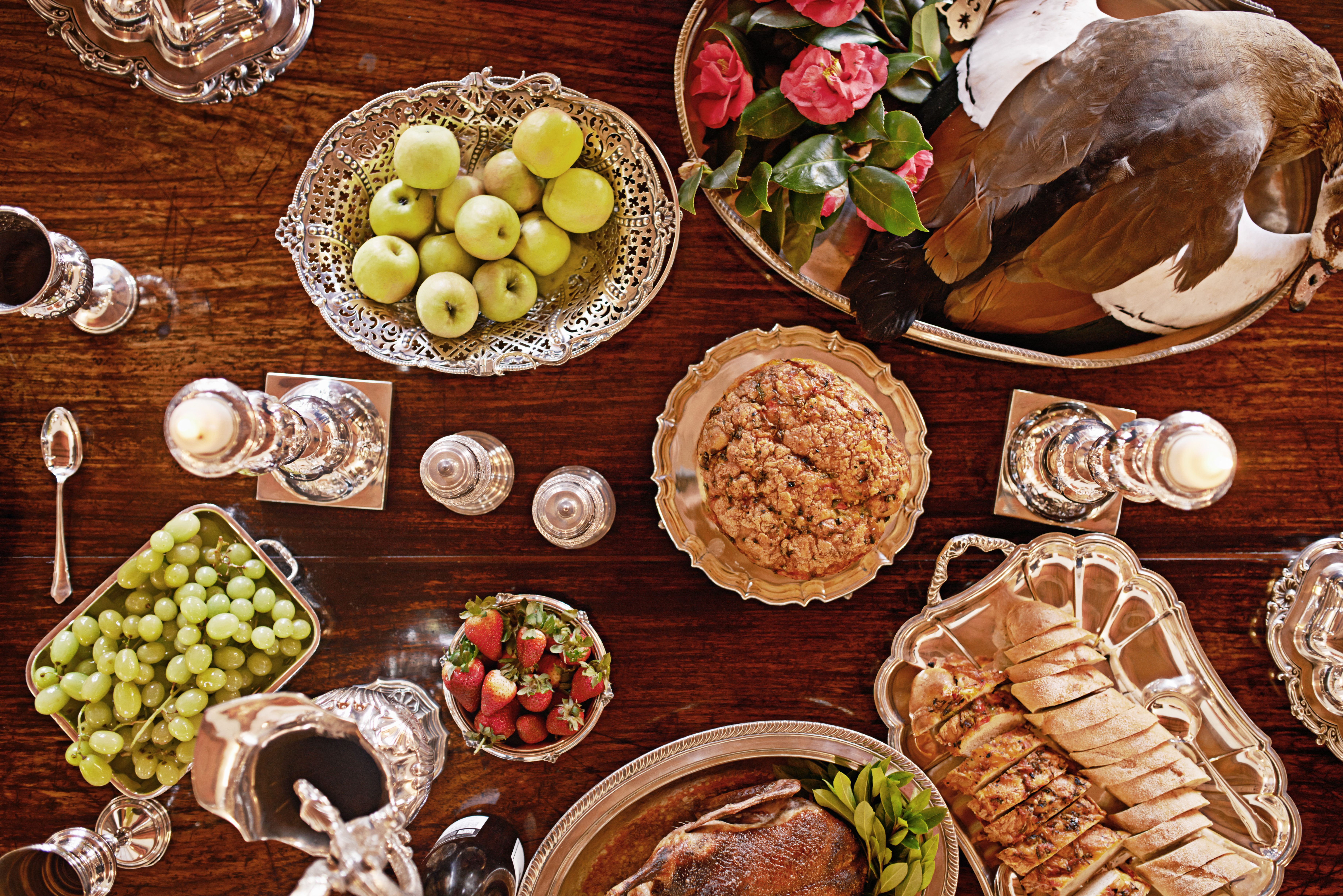When we think about the royal family, we often imagine a life of decadence and splendor. We watch their fashion choices closely, we try to guess the names of their future children, and we go absolutely manic when they get married. But what about their food choices? Do royal family meals consist of eating caviar and sipping on expensive wines every day, or do the royals make hunger-inspired McDonald’s runs like the rest of us?
We already know that Meghan Markle has a deep passion for food (she even co-wrote a cookbook) and that the royal kiddos have to follow a few specific and sort of quirky food rules — but what’s on the day-to-day menu? And what about royal banquets? Can they indulge in a pint (ice cream or beer — you decide) after a long day? Do they order in some nice take-out or enjoy fish n’ chips? (Actually, yes. William and Kate love to order curry while binge-watching HBO). And what about England’s kings and queens of the past? Is it all turkey legs and mead? The answer is, basically, yes.
Let’s take a look at what England’s royal family ate throughout history, starting with a look at the royal family’s preferences today.
The queen has to be pretty health conscious.
Queen Elizabeth II has always been in good health. This may be due in part to the fact that she follows a rather smart diet. She keeps away from low-nutrient, starchy foods like pasta, potatoes, and bread (especially for meals like lunch). And if the queen does eat pasta, it’s freshly made —and definitely not out of a box. She instead focuses on cleaner eats like grilled fish and freshly picked strawberries — you know, from her own estate in Balmoral, Scotland. The catch: She will only eat seasonal fruits, so if it wasn’t born of the earth on its own, she’s not interested.
So, what will you never find in the royal family’s meals? Garlic and shellfish — both are forbidden.
Why, you ask? Well, shellfish could get any of the royals sick without warning, and the queen thinks garlic is straight-up gross. And if she doesn’t like it, it definitely won’t be found in any royal dishes.
The queen enjoys a nice Sunday roast.
Just like any other family, the queen and her kin like to chow down at a nice Sunday roast, and – according to her former chef – the queen, prefers her meat well done. Oh, and she likes her mushrooms cooked with a dash of Marmite. Marmite, for those who aren’t familiar, is certainly an acquired taste.
The queen is not a foodie, nor a big lover of food.
In fact, one former chef explains, “Sadly, the Queen is not a foodie. She eats to live, unlike Prince Philip who loves to eat and would stand and talk food all day,” as noted in the Telegraph.
The queen loves a stiff drink.
Many pieces have been written about the queen’s love for a good drink. While perhaps it’s become a bit exaggerated, it’s likely that she enjoys a drink just about as often as the rest of us. After all, she is the leader of a country with a lot on her mind, so she deserves her share of gin and Dubonnet cocktails (with a lemon slice and some ice, just like the Queen Mother did).
Reportedly, she also enjoys a bit of wine and champagne throughout her day.
Even the royal corgis eat well.
One former chef recalls making an elaborate, delicious dish: “I simmered rabbit, cooked down some chicken, then finely chopped the meat, sieved the stock, and returned the meat… It was the corgis’ dog food.” In fact, the royal corgis are universally adored and have long been a part of the royal family makeup. Apparently, the queen has owned over 30 corgis since her coronation in 1952. The royal corgis even have their own Wikipedia page.
Prince Charles is a big fan of organic and foraged foods.
It’s known that the Prince of Wales and Camilla, Duchess of Cornwall, are fans of organic and sustainable eats — and good on them for promoting it! In fact, Prince Charles been called “one of the forerunners of the organic movement,” according to Today. Prince Charles owns an organic farm — one of the very first certified organic English farms — at Highgrove House, his private residence.
Prince Charles even grows fruits and veggies, and has his menus planned around foods that can be foraged — like wild mushrooms.
Yum! We wonder if he likes Marmite on his mushrooms, too?
Now let’s go a little further back in time and look at some of England’s kings and queens’ favorite royal meals.
Queen Victoria ate some seriously decadent foods.
During Queen Victoria’s reign — which lasted 63 years from 1837 to her death in 1901 — important occasions would see the Queen eating cod and oyster sauce, duck in Cumberland sauce (a fruit sauce), and roasted lamb. Desserts would include chocolate profiteroles (basically a creme puff drizzled in chocolate). Diners were also often served fine wines, although Queen Victoria would prefer to drink whisky. It’s safe to say Queen Victoria had great taste.
Queen Victoria was a huge fan of food in general and had to be kept on a restricted diet as a child.
Fun fact: Queen Victoria’s dinner table is where several rules of royal etiquette were born.
In one infamous case, someone told a joke to the queen, to which she allegedly uttered, “We are not amused.” It was said that Queen Victoria barked this phrase at a dinner at Windsor Castle, although this cannot be verified. Apparently she was known to be a very sweet woman, despite the rather intense facial expressions recorded in her portraits.
King Charles II was a major foodie.
King Charles II was all about food fanfare and would host elaborate eating rituals at least once per week. During these royal family meals, he would be served 26 different dishes by his own master chef, and kept to the traditions he grew up with in Whitehall Palace by always ensuring his meals included “salt, silver-gilt plates, spoons, forks, and four gold dinner plates.” King Charles II would sit at his raised table, under a canopy, with just a handful of people at his side. Below him, everyone else would eat.
King Charles II also loved pineapple and was probably the first person who ate it in England.
During this time, royal family meals were served in courses, but in “stages of service,” according to the BBC. These stages might involve hundreds of plates of food, many of them including meat and root veggies.
Allegedly, the first recorded evidence of ice cream came about during King Charles II’s reign, when it was listed on a menu.
It’s said that modern ice cream was born from Persian sherbet, which was popularized in Italy after the Persians conquered Sicily. When Catherine de’ Medici tried it in Florence, she brought the dessert with her to Versailles and had King Henry II, her husband, try it – and thus it became part of royal family meals. And from there sherbet evolved into ice cream and became the treat we know and love.
When it came to royal family meals, Henry VIII knew how to throw a serious foodie party.
Henry VIII, who reigned from 1509 to 1547, was known to have a serious appetite — both for food and for murder. Apparently, his palace was filled to the brim with kitchens and cooks preparing all kinds of food.
In fact, Henry VIII was said to have almost 20 kitchens.
As one Spanish visitor stated about his visit to Hampton Court, “There are usually eighteen kitchens in full blast and they seem veritable hells, such is the stir and bustle in them…there is plenty of beer here, and they drink more than would fill the Valladolid River.”
Henry VII’s kitchens were full of pig-roasting spits and open fireplaces.
Hampton Court also has “50 smaller rooms for dealing with fish, making pastries, or pickling and bottling,” according to Owlcation. So with all that to-do, what was the king actually eating? Well, he chowed down on the good stuff — you know, swan, venison, peacock, heron, and seagull. Yes, you read that correctly. During the royal family meals they were eating peacocks — and seagulls! For goodness sake, they were eating the poor peacocks!
Royal chefs had an interesting method for cooking peacocks.
While we’re used to ostentatious shows of wealth from the royal family today, few of them are quite as quirky as what the royals enjoyed back in the day – particularly when it came to the plating roasted peacocks. According to Peter Hammond, author of Life In A Medieval Town, “Sometimes the skin of a peacock would be carefully removed along with the feathers… Once cooked, they were replaced, as if it were still alive. They did this to show wealth.”
Henry VIII was big on butchered meats, and loved to feast on deer, oxen, and calves.
Queen Anne Boleyn is said to have loved venison.
Queen Anne, who reigned from 1533 to 1536 (and was eventually beheaded by her husband, King Henry VIII) probably enjoyed all the above Tudor-loved foods, too. However, she may have had a special affinity for venison, which wasn’t something just anyone could get their hands on. It was only available to the king and other high-ranking nobles, who would often have it hunted and cooked on demand for royal family meals.
Allegedly Henry VIII wooed Anne with gifts of venison, which was also a symbol of courtship.
It’s safe to say that she probably liked venison a lot. And that wouldn’t be too far off from the sort of delicacies found in the royal family’s meals today. According to Mashed, the queen loves to eat venison that has been reared and hunted on land she owns, like at Sandringham or Balmoral.
One particularly cool thing about traditional royal family meals? Dessert was served throughout the meal — not just at the very end.
Can we go back in time, please?
Back during King Edward IV’s time — which went back even further to the 1460s-1480s — the King would dine on fine meats and fish. Like King Charles II, King Edward IV ate sweets alongside his dinner, not after. Although the royal family certainly has a bloody history — as well as a history of interesting food cravings (swans? seagulls?) — today they’re setting a pretty good example for the rest of us with their focus on healthy eating, community empowerment through food, and the consumption of sustainable, ethical foods.

